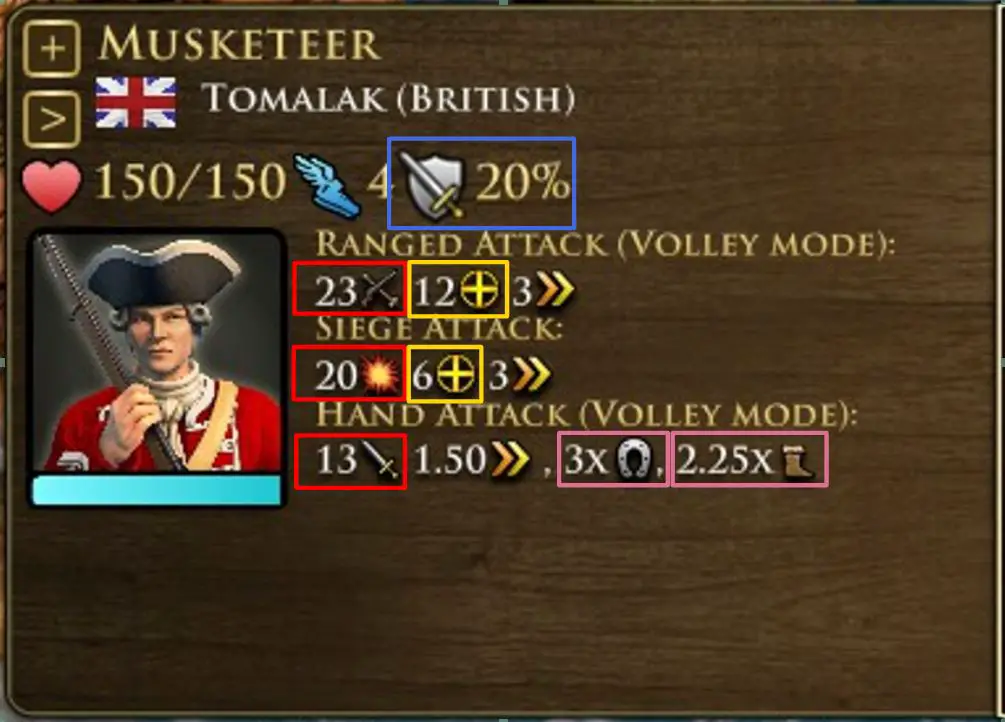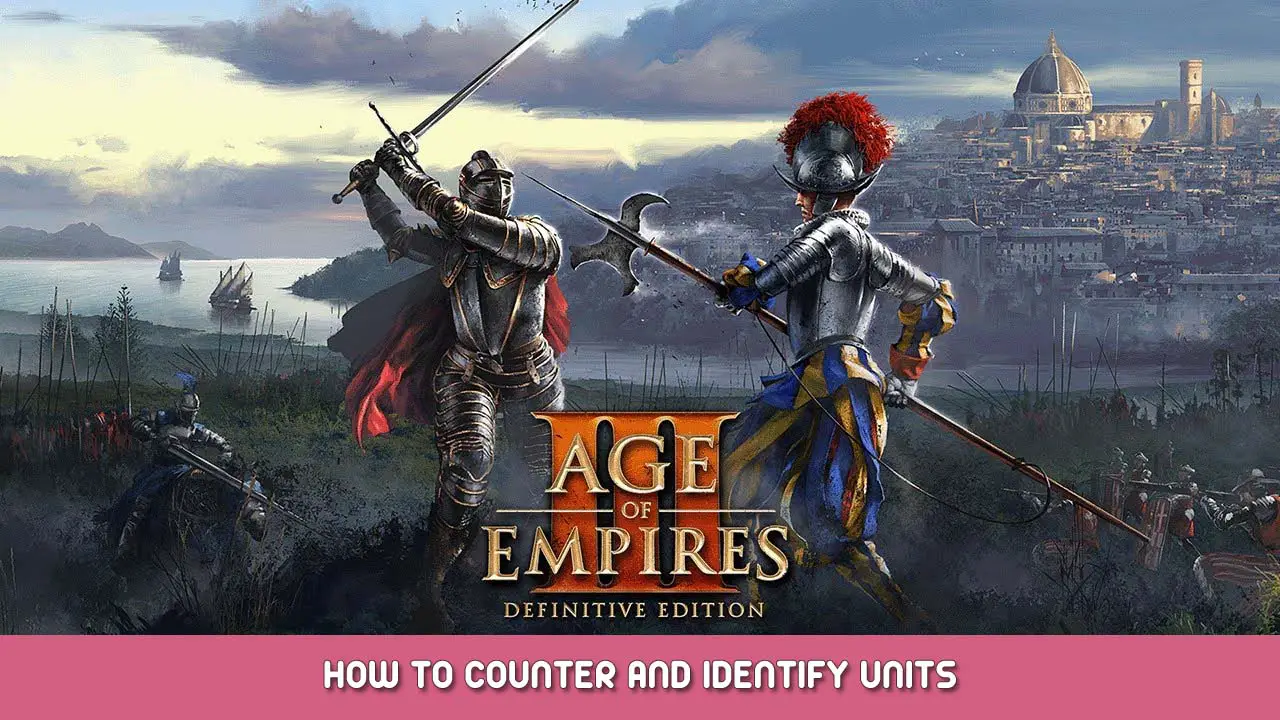Explanations & Rules of thumb about the tag-based counter system, covering exceptions and exotic units.
Preâmbulo
Trabalho em andamento:
Observação: Most important aspects should be covered already, however it should be stated that:
Not Covered yet / To do:
- Resistances in various Stances
- Charged Attacks / Variing speed Attacks
- “Exotic” Units in detail (Own section)
- Most noteable “non-exotic” Units in detail (Own section)
- Outlaw Units (will be implemented in existing sections)
- Revolutionary Units (will be implemented in existing sections)
Se você tiver alguma dúvida, sugestões, critics or found any mistakes, especially forgotten exceptions not mentioned above, please make liberal use of the comment section!
Introdução
I think its quite easy being said that one of AoE III greatest features and biggest bane is its continously growing variety of more or less unique units. (~200 I think)
Especially with the last update of October making anti-intuitive units easier accessable – this guide is proposed to aid new as experienced players to easier get along sem knowing every single unit.
Assuming you are not able to completely out-micro, out-number, or out-tech your enemy, which will be the vast majority of the time, you will have to bother about what type of unit is best against what other type.
In AoE III units are defined by tags and so are most of their strenghs and weaknesses.
Tag are important, since most Units deal dano extra para specific tagged unidades.
Beijósticos e Skrimishers deal extra damage (1.25 para 3 vezes) para Infantaria pesada e (2.0 vezes) Cavalaria Ligeira por exemplo.
From all unit tags como:
Infantaria, Infantaria leve, Infantaria pesada, Ranged infantry, Musket Infantry, Archaic Infantry, Cavalaria, Cavalaria pesada, Siege Units, Artilery, Native Units, Mercinaries,… – I could continue this further but I think you agree that there are many of them.
Not all Tag are equally important. Na verdade, you actually don’t ultimately have to bother too much with them, since there are some simple rules to easly see (by klicking on the Unit) what it is strong and what it is weak against.
Exemplo (1)
In the tool tipp below you can see primary stats like
Saúde, Dano, Attackspeed, Movementspeed;

Mas também:
Resistência: Blue Bracket
Dano & Damage Types: Red Brackets
Faixa: Yellow Bracket
Multipliers: Rosa Brackets
This Musketeer for example got: Melee Resistance, Ranged Attack com no multipliers,
Siege Attack (Only usable vs buildings) com no multipliers e Melee Attack com [3x VS Cavalry] e [2.25 VS Shock-Infantry] multipliers.
Por falar nisso: You don’t need to know the symbols – simple mouse-over will tell you the meaning.
While being self tagged as:

(You can get this window by mouse-over the portrait of the previous tooltip screen)
Here we can see it is:
–Infantaria
–Ranged Infantry
–Infantaria pesada
What does it mean?
- With its Melee-Resistance isto deve perform well against all units that deal Melee-Damage.
- Isso é Ranged Attack pegou no multipliers – so that is neither especially good or bad.
- Isso é Melee-Attack however got 2 different multipliers: 3x Cavalry – meaning it will deal
3 times the damage to every unit tagged as Cavalaria e 2.25 vezes the damage against as Shock Infantry tagged units.
So this is a unit that deve do well against Cavalaria e Shock Infantry in Melee – since it takes less Melee Damage and deals more to this type of units.
While on range it is more allround.
Observação: Shock Infantry looks like Infantaria but is technically not tagged as such, which fulfills the role of (majoritariamente) Cavalaria pesada – and is usually also treated alike by other units -> Artilharia negócios menos danos para Cavalaria & Shock Infantry and so on. Shock Infantry is typical for Native American factions but in particular for the Aztec as they lack any type of classic Cavalaria
Rules for easier identification of Tags & Unit-Types
Alguns Basic-Rules
- If it got a ranged attack – it is its primary attack.
- If it got a ranged attack it deals ranged damage with its ranged attack.
- If it got melee attack it deals melee damage with its melee attack
Alguns other Rules
- If it got a piky end (speers, bajonets, espadas…) – Isso é Infantaria pesada ou Cavalaria pesada
- If it shoots arrows – isso é Infantaria leve ou Cavalaria Ligeira
- If it got a musket e é mounted – Isso é Cavalaria Ligeira
Observação: The Rules above are not reverse applicable (there is some Infantaria pesada sem piky ends) and can only be applied for units in their standard stance, Longbowmen for example use swords if forced or set to melee stance but are still Infantaria leve
Furthermore regarding Infantry:
- Se for apenas fighting in Corpo a corpo isso é Infantaria pesada ou Shock Infantry and countered by Heavy Ranged Infantry but not only.
- If it got Melee Resistance isso é Infantaria pesada
- If it got Ranged Resistance isso é Infantaria leve
For exceptions see the “Systematics of Units” section below.
Basic Counter-System: Pedra, Papel, Tesoura
In AoE III we got a fairly complex counter-system, consisting of many different types of units countering other units, what makes it sometimes possibly counter even mixed armies with a single type of unit.
However there are some rules applicable most of the time:
Rough Counter-Rules:
- Infantaria mata Cavalaria (neglecting Infantaria leve like Bowmen & light Cavalry)
- Cavalaria mata Artilharia
- Artilharia mata Infantaria (neglecting some exotic units)
A little bit less rough Counter-Rules:
- Infantaria leve mata Cavalaria Ligeira & Infantaria pesada
- Infantaria pesada mata Cavalaria pesada & Infantaria pesada
- Cavalaria Ligeira mata Cavalaria pesada & Artilharia
- Cavalaria pesada mata Infantaria leve & Artilharia
- Artilharia mata Light Infanrty & Infantaria pesada
Systematics of Units
Infantaria
- Exceptions(1) Urumi (Apenas Infantaria neither Luz- or Heavy)
- Infantaria pesada
- Ataque: Ranged and/or Melee
- Exceptions(1): Inquistor(Siege Damage on quasi Melee Attack)
- Amor: Only Melee
- Exceptions(5): Carolean(À distância), Papal Guard(À distância), Nizam-Fuslier(Cerco), Yamabushi(À distância), Desert Warrior(Switching)
Observação: O Carolean starts like a normal musketeer with Melee Amor and switches it only once and irrevesible to À distância depois do age IV homecity card: “Svea Lifeguard” is sent.
- Exceptions(5): Carolean(À distância), Papal Guard(À distância), Nizam-Fuslier(Cerco), Yamabushi(À distância), Desert Warrior(Switching)
- Ataque: Ranged and/or Melee
- Infantaria leve
- Ataque: Only Ranged
- Exceptions(2): Sudanese Dervish(Melee on range), Dhaomey Amazon(Melee on range)
- Amor: Only Ranged
- Exceptions(4): Arrow-Knight(Cerco), Huraca(Cerco), Darood(Cerco), Pavisier(Switching)
- Ataque: Only Ranged
- Shock Infantry
- Ataque: Only Melee
Exceptions(1): Eagle-Runner Knight - Amor: Only Ranged
- Exceptions (0): nenhum
- Ataque: Only Melee
Observação: Despite being here listed under “Infantaria”, the tag Shock Infantry é mutually exclusive com Infantaria and in general far more similiar para Cavalaria
Cavalaria
- Cavalaria pesada
- Ataque: Only Melee
- Exceptions(1): Yojimbo
- Amor: Only Ranged
- Exceptions (2): Sennar Horseman, Lifidi-Knight
- Ataque: Only Melee
- Cavalaria Ligeira
-
- Ataque: Only Ranged
- Exceptions (1): Berber Camel Rider
- Amor: Majority Ranged
- Exceptions (7): Arqueiro de Cavalaria, War Wagon, Bow Rider, Black Rider, Manchu, Berber Camel Rider, Comanche Horse Archer
- Ataque: Only Ranged
So in total out of ~200 units there are only ~ 24 “esquisito” combinations of Tag, Resistências e Attack Types
Isso é tudo o que estamos compartilhando hoje para isso Era dos Impérios III: Edição Definitiva guia. Este guia foi originalmente criado e escrito por Tomalak. Caso não atualizemos este guia, você pode encontrar a atualização mais recente seguindo este link.
